Without New MTA Funds, Transit Riders May Face Return of 70s-Era Disrepair

Last week we wrote about how the looming $10 billion deficit in the MTA’s capital plan could lead to a $3.00 fare and $137 monthly pass within three years. That’s not the only way the transit authority could decide to respond to a lack of funding, however.
At the other end of the spectrum from fare-backed borrowing, the MTA could decide that it cannot take on any additional debt. In that scenario, the MTA would simply have to cancel or postpone every unfunded maintenance and expansion project — most of the next three years of the capital program. You can see those projects at the MTA’s capital dashboard, here. The result will be breakdowns, delays, and a slide back toward the decrepit and dangerous subway system of the late 1970s.
“You can expect to see the condition of the system decline pretty rapidly if you’re not doing this work,” said Felice Farber, the director of external affairs for the General Contractors Association of New York. “It’s not too hard to get back to the poor quality service of the past,” she said.
“You’ll have older buses, so they’ll be breaking down more often,” explained Pete Foley of TWU Local 100. “Subways will have to go slower,” as they pass over worn out tracks, he continued. “Eventually you’re going to have cracks. You’ll have derailments if you have a crack in the rail.”
Delays will be more common during rush hour as well, due to the lack of regular preventive maintenance. “You’ll be fixing things when they break,” said Foley. “They’ll wait until it’s an emergency.”
In the final three years of the capital plan, Farber said, 23 percent of the cost is network expansions like East Side Access, 27 percent are basic repairs to the system, 35 percent goes to regular replacement of tracks or buses, and thirteen percent to system improvements like new communications technology.

Over time, said Farber, putting this work off would force riders to pay more for less. “What happened on the New Haven line is the perfect example of what happens when you defer maintenance.” In 2000, then-governor John Rowland refused to buy new Metro-North cars. That decision ended up resulting in a ten percent service cut during rush hour this winter, when the repairs needed to the old cars overwhelmed the MTA. “They also paid huge overtime expenses while they struggled to get their system up to speed,” said Farber.
Both Farber and Foley noted that even though the capital program is currently funded, the transit system is already starting to struggle. “If you ride the train now, we’re already starting to see train delays because of signals, starting to see the doors have only one side open,” said Farber.
Foley pointed to scaled back plans for the MTA’s mega-projects. One of the two stations on the 7 line extension won’t be built, for example, and the corridors connecting the different subway lines at the Fulton Street Transit Center were narrowed by around six feet.
Station repairs and customer service improvements could be some of the first to go if the MTA’s capital plan deficit isn’t closed. “That’s the direct passenger experience,” said Farber. The current round of station repairs are mostly in Brooklyn and Queens, she said.
The expansion of real-time arrival signs to the lettered subway routes, the new subway intercoms, and security cameras also won’t go into effect, said Foley. “They’ll just have to cut these out.”
In reality, of course, the MTA can choose to mix and match between fare-backed debt and deferred maintenance, putting off the features that might be nice to have and charging riders for the ones they need to have. The MTA could also potentially swap in service cuts or layoffs for fare hikes.
The bottom line is that without the revenue that a solution like congestion pricing or bridge tolls could provide, none of the MTA’s options are good for riders. Should our transit system buy what it needs by taking out a huge loan and sticking transit riders with the bill? Or just let the system begin to fall apart? Albany shouldn’t be content with either.
